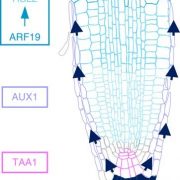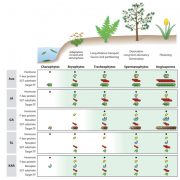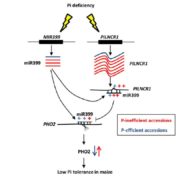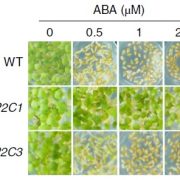Integrated regulation of apical hook development by EIN3/EIL1 and PIFs ($) (Plant Cell)
 The apical hook helps to protect the fragile cotyledons and shoot apical meristem while pushing through the soil, and hook angle determines the success of emergence from soil. Multiple hormones and light signals have contrasting roles in the regulation of hook formation; e.g., auxin, ethylene and gibberellic acid (GA) act as positive regulators whilst jasmonic acid (JA) and light control negatively. HOOKLESS1 (HLS1), encoding a putative N-acetyltransferase, is one of the essential factors for hook formation. Its transcription is regulated by two major transcription factors of ethylene signaling, EIN3 and EIL1. In this study, Hongwei Guo and his team showed that along with EIN3/EIL1, PIFs also independently activate HLS1 transcription. They demonstrated that the quadruple pifq mutant (pif1 pif3 pif4 pif5) is almost hookless with two open cotyledons. Furthermore, pifq ein3 eil1 sextuple mutants have a completely hookless phenotype and minimal HLS1 transcription. In addition, JA-mediated negative regulation of hook formation exploits MYB2, which interacts with EIN3/EIL1 and PIF4 to repress their activities. This work provides an integrated developmental mechanism for hook formation based on hormonal and light signaling pathways. (Summary by Arif Ashraf) Plant Cell: 10.1105/tpc.18.00018
The apical hook helps to protect the fragile cotyledons and shoot apical meristem while pushing through the soil, and hook angle determines the success of emergence from soil. Multiple hormones and light signals have contrasting roles in the regulation of hook formation; e.g., auxin, ethylene and gibberellic acid (GA) act as positive regulators whilst jasmonic acid (JA) and light control negatively. HOOKLESS1 (HLS1), encoding a putative N-acetyltransferase, is one of the essential factors for hook formation. Its transcription is regulated by two major transcription factors of ethylene signaling, EIN3 and EIL1. In this study, Hongwei Guo and his team showed that along with EIN3/EIL1, PIFs also independently activate HLS1 transcription. They demonstrated that the quadruple pifq mutant (pif1 pif3 pif4 pif5) is almost hookless with two open cotyledons. Furthermore, pifq ein3 eil1 sextuple mutants have a completely hookless phenotype and minimal HLS1 transcription. In addition, JA-mediated negative regulation of hook formation exploits MYB2, which interacts with EIN3/EIL1 and PIF4 to repress their activities. This work provides an integrated developmental mechanism for hook formation based on hormonal and light signaling pathways. (Summary by Arif Ashraf) Plant Cell: 10.1105/tpc.18.00018









